- Italy Tours Home
- Italy Ethos
- Tours 2023
- Blog
- Contact Us
- Dolomites
- Top 10 Dolomites
- Veneto
- Dolomites Geology
- Dolomiti Bellunesi
- Cortina
- Cadore
- Belluno
- Cansiglio
- Carso
- Carnia
- Sauris
- Friuli
- Trentino
- Ethnographic Museums
- Monte Baldo
- South Tyrol
- Alta Pusteria
- Dobbiaco
- Emilia-Romagna
- Aosta Valley
- Cinque Terre
- Portofino
- Northern Apennines
- Southern Apennines
- Italian Botanical Gardens
- Padua Botanical Garden
- Orchids of Italy
Cansiglio Alpine Flora and Botanical Garden: a Chance to Get to Know the Main Alpine Habitats.
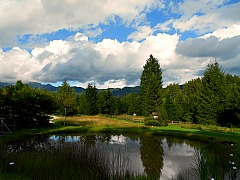
The Cansiglio Alpine Flora page offers a virtual tour of the Cansiglio Botanic Garden (see a general view below) and the many habitats it contains, allowing at the same time to acknowledge oneself with all the main environments that can be encountered when walking in nature – specifically on the Cansiglio and, at large, within the context of the Eastern (or Oriental) Alps.
Please note that for some of the technical names throughout the page an equivalent in Italian is sometimes given; this is intended to assist in the event of a self-guided walk in the Cansiglio Botanic Garden, where most of the signs are in Italian only, with no translation into English.
It is also possible to consult another page that deals specifically with the natural setting of Cansiglio, where the Botanical Garden is located. This garden is also part of a regional network of five Alpine Botanic Gardens.
Sin-anthropic Vegetation
The so-called sin-anthropic vegetation owes its origin to the disturbances to natural habitats due to human actions and activities.
Over the course of the centuries, man has subjugated the natural environment to his necessities: areas inhabited, worked or heavily disturbed have thus become an ideal environment for some species to carry out their life cycle.
Some of these plants come from Eastern Europe and the Mediterranean, while others may have been introduced by man since Neolithic times, with the first forms of agriculture; these latter plants are called archeophytes.
Other species are of more recent introduction, and come from the colonization of extra-European countries – these are known as neophytes.
At the beginning of the trail, in the Cansiglio Botanic Garden, there is a small section with vegetation which is highly conditioned by human activity: these are the so-called “kenosis of trodden places” – areas heavily walked upon and compacted both by grazing animals and humans (i.e. around houses and in courtyards).
Among the plants found here are species such as Common Plantain (Plantago major), Polygonum aviculare, the grass Poa annua and False Chamomile, Matricaria discoidea.
The so-called ruderal vegetation (i.e. typical of ruins) is represented here by those plants that grow at the base of walls, along the streets and in tips, or in other locations where waste material is accumulated, such as many Taraxacum spp.
The good availability of nutrients favours the growth of tall herbaceous – and often spiny – plants such as Wild Wormwood (Artemisia vulgaris), Wild Thistle – Cirsium vulgare; see image below – and Burdock (Arctium lappa).
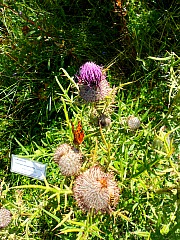
The Vegetation of Wetlands
The first habitat to be encountered in this section are the wet meadows, with the grass Molinia coerulea as dominant species – aka Molinietum (Molinieto in Italian).
This association is usually settled on humid – and more or less peaty – soil, where water circulation is quite superficial. Different degrees of water retention determine the type of vegetation that can be found in these habitats, with species such as Caltha palustris, Crepis paludosa and Scirpus sylvaticus.
The Molinietum is a good example of semi-natural vegetation where the action of man was limited to hay-making, the taking of bedding straw and the production of hay of lesser quality – nevertheless without significantly altering the original vegetation composition.
Nearby is a pool, locally known as ‘lama’ (see image below): this is typically a circular small expanse of water, originated by rendering impermeable the bottom of a ‘doline’ (sink-hole) after the deposition of clay or of calcareous material.
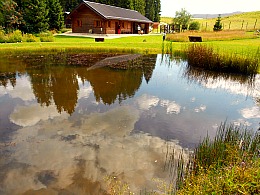
In a karstic setting such as the Cansiglio, the presence of
these pools is fundamental, as they are in fact the only places in which there
remains a reserve of water even in periods of drought; here species such as Typha
latifolia, Schoenoplectus
lacustris, Water Speedwell (Veronica beccabunga) and Eleocharis palustris can be seen.
The other side of the pond from the small bridge is dedicated to the vegetation of the Laghi di Revine (Revine lakes) – an area of outstanding naturalistic beauty at the foothills of Cansiglio: in these lakes, only partly modified by human activity, old plants still survive; in the garden, for conservation purposes, are kept species such as White- (Nymphaea alba) and Yellow Water Lily (Nuphar luteum; see picture below), as well as Frog’s Bite (Hydrocharis morsus-ranae).
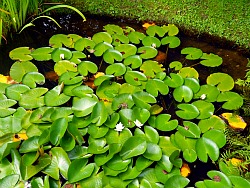
Peat-bogs (in their acid and basic forms) are particular environments that are formed by the concurrence of various mechanisms, amongst which low temperatures and abundance of water are key. The combined action of these factors, together with a rise in the acidity of soil pH, slows down the activity of micro-organisms, determining the accumulation of un-decomposed vegetal material – better known as peat – which progressively causes the pool to fill up.
In the peat-bogs (see an image below), the processes of decomposition of organic matter – through which nutrients return to the plants – are highly slowed down; this causes, in turn, a lack of important elements for vegetal life, such as nitrogen and phosphates.
As the soil is constantly waterlogged, this puts the root systems under stress, thus making peat-bogs difficult habitats in which only highly specialized (and often carnivorous) species – such as Drosera rotundifolia – can thrive: plants able to make up for the little availability of nutrients by capturing insects.
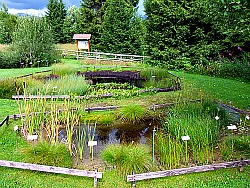
Low-acid peat-bogs particularly favour the growth of such plants as Drosera rotundifolia, but also of other species like Eriophorum angustifolium, the violet Viola palustris – as well as an abundance of Sphagnum moss.
Low-basic peat-bogs, in turn, form where the rocks are calcareous and surface running water is rich in calcium salts, which can block the acidity.
The soil is neutral or basic, and the vegetation that can be found there is mostly composed of superior plants – such as Carex davalliana, C. lepidocarpa, Eriophorum latifolium – and mosses, although these are present in much less quantity in comparison to acid peat-bogs.
Sphagnum mosses – which are a quintessential indicator of acidity – are completely lacking from this type of peat-bog.
Nearby is also a collection of willows (see a specimen below) – especially those that can thrive in more humid conditions and in soils rich in peat such as Salix pentandra, S. caesia and S. rosmarinifolia.
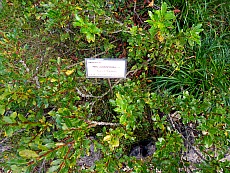
This term is referred mainly to the tygeomorphology of karstic phenomena, dominant in the garden. Karstic landscapes are created by the presence of morphologic forms that can easily be eroded by water, as well as being linked to the abundance of precipitation.
Karstic phenomena (‘carsismo’ in Italian) are derived from the slow dissolution of rock due to the action of water on calcareous rock. The extension, depth and type of erosion depend on the nature of the rock itself, its morphology, and the more or less acute presence of cracks.
In particular, wherever there are geological formations coming to the surface – as with grey limestone – the degree of erosion augments (it is estimated that, in the mountains of Veneto, the dissolution of bedrock operated by surface karstic phenomena is in the order of 1 to 3 cm for every 1000 years – so it is a relatively fast process, in geological terms).
In general, karstic action tends to take different shapes; in Cansiglio, for instance, it ranges from the wide closed basin of the Cansiglio plateau as a whole (‘polje’) to the ‘uvala’ (small depressions) on its edges, such as Cornesega and Valmanera, to the even smaller sink-holes known as ‘doline’.
By the proper sink-holes – which act like entry points to complex subterranean systems made of caves, tunnels and ‘rooms’ – one can observe reef limestone, which is the predominant rock type in eastern Cansiglio and on Monte Cavallo (2,251 m).
This particular limestone –
compact and rich in fossils – bears witness to the activities of
several marine organisms such as corals, mother-of-pearl and algae, which
millions of years ago formed a barrier reef that separated a relatively shallow
submarine platform to the east from a deeper sea to the west (the so called Bacino Bellunese; Belluno basin),
towards where lies today the provincial capital of Belluno.
Alpine Habitats
At the end of the karstic section one enters the heart of the garden, where all the more typical Alpine habitats – such as scree, steep rock faces and Dwarf mountain pine scrubland – can be found.
These latter are shrubby formations that can be encountered in nature mainly along steep slopes, on soils that are not too developed and often prone to landslides, where Dwarf mountain pine (Pinus mugo) thrives as a leading species, and manages to successfully contrast erosion phenomena.
This is a plant with a creeping habit of growth, highly resistant to weather adversities thanks to the elastic nature of its wood; from an altitude point of view, Dwarf mountain pine can grow from the valley floors (400-500 m) to 2,000 m (Alpine pasture lands).
As a consequence, when rising in altitude one can encounter very diverse associations in which Dwarf mountain pine is always present as a leading species, but the accompanying species may vary.
Starting with the lower slopes, we find first a warmth-loving formation (“mugheta termofila” in Italian); montane scrubland follows, which from the limit of the woods (tree line) can reach up to about 1,600 m, and where Dwarf mountain pine is accompanied by such other trees as whitebeam, mountain ash, maples and willows (especially Salix appendiculata).
In the basophile scrubland (“mugheta basofila”), the presence of hairy Rhododendron (R. hirsutum), Dwarf Juniper (Juniperus nana) and the grass Sesleria varia becomes more prominent, while the few rare trees left tend to take a more contorted, straggly shape.
Where the terrain is less steep, conditions are ideal for the formation of a more acid subsoil, which favours the growth of species such as Rhododendron ferruginuem, Blueberry (Vaccinium myrtillus) and Marshland Blueberry (V. gaultheroides). This is termed in Italian “mugheta microterma termofila”.
The vegetation typical of scree (‘macereti’ in Italian) is encountered just after. These types of habitat have their origin from the continual disaggregation of rock, which falls down to form the underlying slopes, dominated by detritus that – because of gravitation – piles up against the rock faces according to its various dimensions.
The smaller fragments stop immediately by the rock walls, while as the stones grow bigger, they deposit themselves further down, in correspondence of sheer changes in gradient.
As screes form at all altitudes, the plants that find their home here are constituted by different species that change in accordance to altitude, aspect and dimension of the actual detritus in which they grow.
Naturally, such a harsh and dynamic environment can only be inhabited by a highly specialized flora that can count on a robust root apparatus, while the aerial section of the plant has to be resistant to mechanical stress and to the friction with stones.
In the beds hosting this type of vegetation in the Garden we find Adenostyles glabra, Petasites paradoxus, the grass Festuca spectabilis; further up, there is another Fescue grass (F. laxa), plus Athamanta cretensis with the Dock Rumex scudatus.
Finally, once near the actual rock walls – where the scree is more active and constituted by fragments of smaller dimensions – one finds an association dominated by Alpine Poppy (Papaver rhaeticum; see first picture below).
This is accompanied by species such as Thlaspi rotundifolium, Petrocallys pyrenaica and Hutchinsia alpina (second picture below) – all plants that in nature can normally be admired only above 2,000 m of altitude.
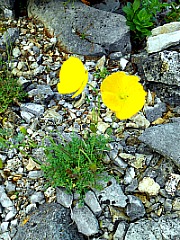
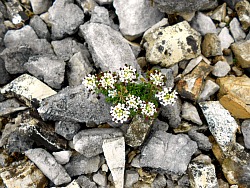
The Firmetum Association
Beside the plants typical of the scree, we find beds hosting more of those species that can be considered proper Alpines and are characteristic of high altitude habitats.
In this part of the Alps, mostly, these are in fact the natural meadows close to the mountain summits. The leading species to be found there is the Sedge Carex firma – from which follows the name of the association: Firmetum (Firmeto in Italian).
Carex firma lives on rocks detritus above 1,800 m of altitude, but can come down to 1,200 m in locations with a more northerly aspect, and can withstand harsh conditions of life, coping with huge thermal excursions ranging from –30° in winter to +50° on the more exposed rocks in summer.
Not to be overlooked is also the abrasive effect of sand and ice particles brought by the wind, which determines conditions of strong transpiration in plants; for this reason, the species that form this association have developed strategies, over time, that can make them withstand extreme situations.
For example, the cushion shape of Saxifrages, the creeping habit of Mountain Avens (Dryas octopetala) and Dwarf willows, the coarse leaves of the Carex species or the abundant hairiness in the leaves and stem of Androsace villosa all equally serve the same function of limiting water loss from the tissues (in the picture, some specimens of Saxifraga spp., noticeable for their compact shape).
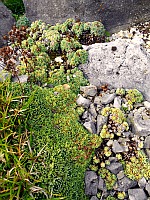
The population of Carex rigida, rich in sub-species – many of which are endemics – offers over the course of the summer a showy and colourful display. The same is also true for the many species of Gentians, Primroses and Cushion Campions that find their home here.
As for the vegetation of calcareous rock faces, here the casmophites (as are defined the plants growing on rocks) brace themselves against a particularly hostile environment, where only highly specialized organisms can survive.
To do so, they need morphological adaptations: first and foremost an expansive root system, which extends itself in search for water and other nutrients deep inside the cracks.
Leaves and stems also need to be resilient, coarse or hairy, and are often grouped in compact cushions known as ‘pulvini’ in Italian (from which the English term ‘pulvinate’) – a typical shape displayed for instance by Saxifrages (see image above; and, in the first picture below, S. caesia, while the second image portrays S. moschata), inside which a favourable microclimate is maintained thanks to the humus formed by the dead parts of the plant itself (mostly the leaves of preceding years).
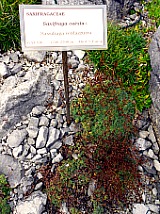
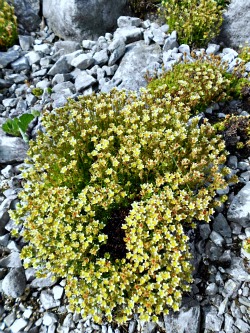
As scree habitats can be found at all altitudes – from the valley floors to the high summits – with different conditions of sun exposure or aspect, and in relation to rainfall and wind, the plants growing there can present themselves quite differently too.
They can be resilient and coarse on sunny slopes, while in shadowy and damp locations their appearance is more frail and delicate (these latter include plants from the genus Cystopteris, as well as Arenaria huteri).
On more compact and inhospitable rock faces superior plants give way to algae and lichens; in fact, the latter can rightly be considered the true inhabitants of the rocks.
From the viewpoint of altitude, in the more elevated locations plants of the crevices (‘rupicole’) populate stations close to or mixed with plants of the Firmetum but, in comparison to the latter association, the former tend to live in locations which are more exposed to changes of temperature and wind, where snow cannot therefore function as much as an insulant.
In these environments, plants like Minuartia chledroides (see picture below), Eritrichium nanum, Potentilla nitida and Saxifraga squarrosa thrive.
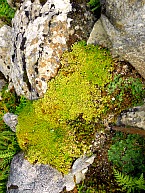
In the montane zone, the most characteristic species is perhaps a Cinquefoil, Potentilla caulescens (see picture below), which gives its name to an association with other endemics such as Spiraea decumbens subsp. tomentosa and Devil’s Claw (Physoplexis comosa).
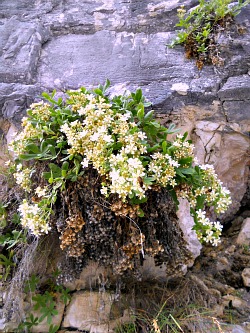
Worth mentioning again is Arenaria huteri, which is an endemic to the slopes of the Val Cimoliana and Val Cellina (in the Dolomiti Friulane), where it grows on damp crevices.
The so-called nival (or snow) valleys are those places where snow lingers for the longest time in a year, such as at the base of the canals (canaloni), at the bottom of the ‘doline’ and sink-holes formed by the blockage operated by moraines, or because of the presence of rock boulders.
There, over time, a noticeable layer of clay and lime brought by the movement of snow and melting water is accumulated; the soil is therefore not very permeable and damp for most of the vegetative period, but it is nevertheless rich in humus, thanks to the organic matter which is being deposited mainly by the plants that grow in those locations.
To the side of these small valleys – where snow is present for less time – a good availability of nutrients favours the growth of tall herbs such as Monkshood (Aconitum napellus, A. lamarkii, A. paniculatum; see first picture below) and Spiny Thistle (Cirsium spinosissimum; second picture below).
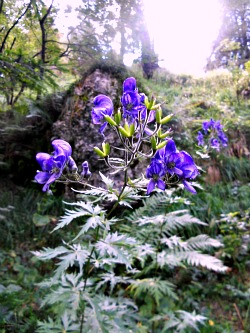
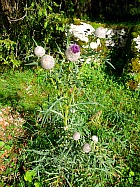
Snow valleys are among the most characteristic habitats for Alpine vegetation; the plants that populate them have to accomplish their life cycle in very little time, and in certain years – with less favourable weather – this may not happen at all.
Real champions of adaptation, in that respect, are the creeping willows: Salix retusa and S. reticulata manage to prepare to vegetative activity by anticipating the melting of snow, and by forming their new buds while still under a blanket of snow; this adaptation strategy is shared also by the Alpine Bluebell (Soldanella alpina; see image below).
Other species typical of this habitat include Saxifraga androsacea, the Alpine Buttercup (Ranunculus alpestris) and the Sedge Carex parvifolia.
Exceptionally, on the calcareous mountain slopes of Alpago, one can also spot Sibbaldia procumbens – a species which is exclusive to nival valleys with siliceous subsoil.
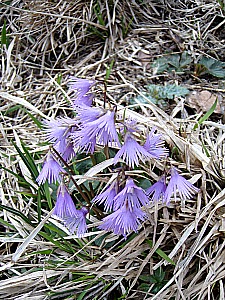
The Seslerietum Association
As one gets away from the snow valleys, we enter the grassy slopes where Sub-alpine pastures are dominated by two grasses, Sesleria varia (the leading species, as the name suggests) and the Sedge Carex semprevirens.
These populations, situated on calcareous scree (‘macereto’ in Italian) – preferably exposed on a sunny aspect – are distributed on a wide altitudinal band that ranges from the tree limit in the lower reaches up to the Firmetum above.
The work of colonization over the scree slopes by the Seslerietum plants’ association starts with a few pioneer species like Mountain Avens (Dryas octopetala; see picture below) and the creeping willows – such as Salix alpina and S. serpyllifolia.
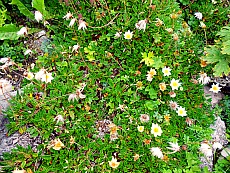
These first few areas of firm vegetation progressively increase their surface in patches, and eventually become united to form a homogeneous meadow, only interrupted here and there by isolated rocks and boulders.
Nevertheless, due to the natural mobility of the slope, the Seslerietum manages to retain a certain dynamic; therefore, from discontinuities on the grass surface, a formation resembling a mosaic or ‘stairs’ starts to form, with continuous changes in gradient and the creation of micro-habitats able to fulfill the ecological needs of different plants.
Some of the plants shown in this part of the garden – especially those that are more needy from a thermal point of view – can reach particularly high locations in nature, climbing up to 2,800 m of altitude: it should therefore not come as a surprise that in the Seslerietum one can expect to find a considerable number of different species.
Indeed, in the most favourable spots more than 60 species can be found within 100 square metres of pasture land, amongst which are endemics such as Horminium pyrenaicum and Senecio abrotanifolius.
Other plants catch the eye of the observer with their colourful blossoms – and these include Alpine Aster (Aster alpinus; see first picture below), Anemone narcissiflora, the Pedicularis (P. elongata and P. rostrato-capitata) and, lastly, the Edelweiss (Leontopodium alpinum; second picture below).
This plant is often considered to be the symbol of the Alps, but it is in fact of steppic origins, and it has found in this relatively hot and arid climate an environment that suits its needs.
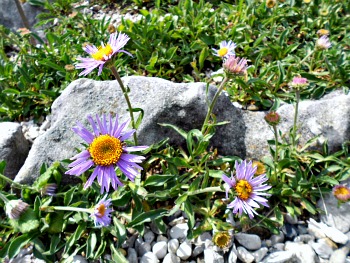
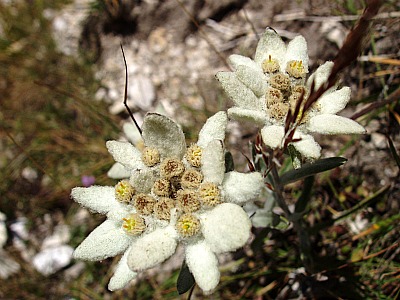
The Festucetum Association
Next to the Seslerietum we notice an area where rock faces are steeper, and the tufts of the grass Sesleria varia give way to the more spiky leaves of Alpine Fescue grass. This formation is known as Festucetum (‘Festuceto’ in Italian).
The leading species of this association – Festuca alpestris, endemic to the south-eastern Alps – finds its home on steep calcareous rocky crags and on detritus, especially in hot and dry locations facing south, generally at low altitudes, but reaching occasionally 2,000 m in the most favourable spots.
This species represents a good example of adaptation to conditions of high aridity: its leaves, for example – spiky and of a cylindrical shape – are formed by two halves of a blade folded in a longitudinal fashion.
In this way a crack forms, through which the gassy exchanges with the atmosphere can happen; in conditions of high aridity the two halves close, thus limiting transpiration and hence preventing loss of humidity.
The root system of this grass, also – continually in search for water – is strong and voluminous, and anchors the plant to a dry soil, poor in nutrients.
The association with Alpine Fescue grass groups several species, many of which are endemic to the southern Pre-Alps of Veneto and Lombardy; amongst these, Laserpitium siler stands out for its dimensions, as does Ligusticum lucidum subsp. seguieri (pictured below) – both in the Umbelliferae family.
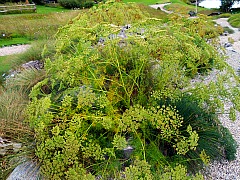
The broom Genista radiata is instead an ancient witness of the tropical climate of the Tertiary era (60 million years ago); other species include Pedicularis gyroflexa and White Betony, Stachys alopecuros.
The vegetation of arid rocks is found past the area with Alpine Fescue grass formations: this is the elective environment of those plants that thrive on hot and arid rocks with sandy soils, generally quite shallow and permeable.
Situated at a low altitude, this environment is colonized by a pioneer vegetation which is constituted mainly by succulent plants such as those in genus Sedum (S. sexangulare, pictured below; S. acre, S. montanum subsp. orientale) and the Houseleeks (Sempervivum sp.), perfectly adapted to habitats exposed to both intense sunlight and summer drought.
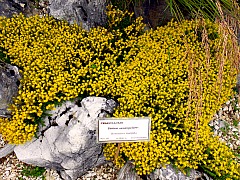
Often, we find these species growing on artifacts that resemble their original habitats – for instance, on walls and roofs (from which Sempervivum tectorum – pictured below – takes its name).
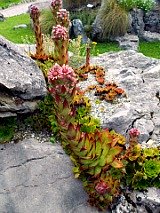
Among other species characteristic of rock habitats that become very hot in summer are Mountain Garlic (Allium lusitanicum), the rock-breaking small Pink Pethroragia saxifraga (see first picture below) and Alyssum montanum (second picture below).
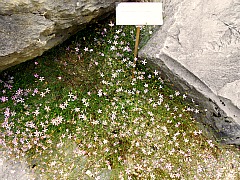
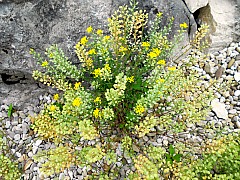
Retracing back our steps now, we can take the path that leads into the Green alder formations (Alnus viridis) with Waldstein willow (Salix waldsteiniana).
This is the sort of vegetation that one frequently encounters above the tree line, when walking along slopes exposed to the north, where elevated precipitations maintain the soil conditions constantly damp but without stagnating water.
While in the internal mountain chains Green alder forms near-pure populations, in the Col Nudo-Monte Cavallo (2,251 m) massif it can be found growing in thickets which are interspersed with Salix waldsteiniana and S. glabra.
Green alder also has the capacity to better the quality and the fertility of the soil (its roots host micro-organisms that can fix atmospheric nitrogen); in turn, this favours the growth of tall herbs (‘megaforbie’ in Italian) such as Adenostyles alliarie, Monkshood (Aconitus napellus – pictured below, A. lamarckii), and Wild Geranium (Geranium sylvaticum).
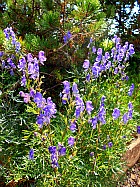
Wood Formations
An area hosting wood formations follows, which presents a highly diversified range. By and large, the most common woodland habitat is composed here by beech: this is indeed the dominant tree species in Cansiglio – and in the mountainous sections of Alpago too.
Beech is a plant that prefers climatic conditions which are not too extreme, being sensitive to both frost and lack of water.
In the most favourable locations, beech can be found up in high mountain reaches, in close contact with Dwarf mountain pine (Pinus mugo); in other situations, it can be encountered either in pure formations or in mixed populations with Silver fir (Abies alba) and Norway spruce (Picea excelsa). The latter is the climax association for the woods of Cansiglio.
The dense canopy of beech does not allow for the passage of much light, and for this reason many species that grow on the beech wood floor (known as ‘geophytes’) have to anticipate their blossoming time before the tree leaves even appear – thanks to their subterranean reserve organs.
In the garden beds, we first encounter the warmth-loving beech formations (“faggeta termofila” in Italian): this type of woodland develops on the sunny slopes of the sub-montane vegetation band (600-1,000 m), in direct contact with warmer formations mixed with Hop hornbeam and Manna ash.
These are situations in which permeability of the subsoil, coupled with the steepness of the slopes, can cause the formation of a surface topsoil which is not very developed and tends to be arid.
Despite that, the influx of humid currents impacting on the slopes and the abundant precipitation allow for a level of dampness that guarantees a herbaceous vegetation rich in orchids.
Amongst these are Cephalantera rubra, C. longifolia, C. damasonium, the Helleborine Epipactis helleborine, together with other species such as Asarum europaeum and the grass Carex alba – hence the name “beech wood formation with orchids”. Undoubtedly, the most noble and rarest presence here is Lady's Slipper Orchid (C. calceolus), pictured below.
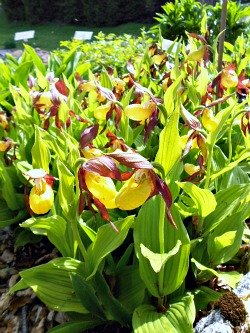
Next is an area dedicated to the mountain beech wood: this particular formation develops on chemically neutral, deep, fertile and relatively damp soil. Associated to beech here are sometimes conifers, and other broadleaves such as Whitebeam, Rowan and Alpine Laburnum.
Typical herbaceous species include Dentaria enneaphyllos, D. pentaphyllos, D. bulbifera, Paris quadrifolia, Mountain Lettuce (Prenanthes purpurea) and various ferns (hence this formation is known as “beech wood with Dentaria”).
Given the extension of the area covered by beech in this region, in addition to the associations just mentioned, mountain beech woods are diversified into several sub-associations – such as the one dominated by Blueberry, which is akin to an acid beech woodland (in terms of soil composition).
This latter formation is partly a product of the permanence of snow on the ground for long periods (that acidifies it), but mostly a consequence of human activities such as animal grazing and tree coppicing.
All Blueberries (Vaccinium myrtillus; V. vitis-idaea) are species decidedly pointing to the acidity of the soil, as is Homogyne alpina.
Nearby, Silver fir formations are represented, in which typical species are Saxifraga cuneifolia (see picture below) and Cardamine trifolia.
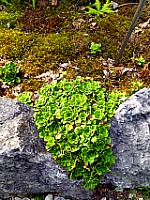
Other plants in this type of woodland tend to be found in wood clearings – where they can take advantage of the higher availability of nutrients, and therefore result in a taller size; these include Deadly Nightshade (Atropa belladonna) and a Bellflower, Campanula latifolia.
The “orno-ostrieti” are characteristic formations of warm habitats (a phenomenon known as ‘termofilia’ in Italian) in the foothill area of Cansiglio, found also in other locations that have a superficial, not very developed and typically calcareous soil – such as on the southern slopes of Col Nudo (2,472 m) and Monte Cavallo (2,251 m).
This is to be considered the most common type of woodland in the pre-Alpine sector of Veneto, where the scarcity of surface water favours species such as Hop hornbeam (Ostrya carpinifolia), Manna ash (Fraxinus ornus) and Pubescent oak, Quercus pubescens.
These woodlands are relatively stable habitats, as evolution towards other types (an association of Hop hornbeam and oaks, for example) is prevented by the traditional practice of tree coppicing and by the morphologic characteristics of the topsoil, which do not allow for this association's evolution.
The herbaceous layer shows here a dominance of grasses such as Sesleria varia and Carex alba, plus a Heather, Erica carnicina.
An area of the garden is dedicated to a type of woodland dominated by Austrian Black pine (Pinus nigra) – a formation that finds its westernmost natural limit along the side valleys of the Piave (such as the Val Tovanella and the Val Montina), as well as on the slopes of the Valle Lapisina and in the val Cimoliana in Friuli.
This is a type of woodland that prefers steep calcareous slopes, with fluid soil and little capacity for water retention, in areas characterized by high rainfall and availability of atmospheric humidity.
Normally, these formations develop on crags with a southerly aspect and in rocky locations, while if planted by man in areas ecologically less favourable these woodlands are more easily prone to fires and/or diseases.
In natural situations, the undergrowth hosts plants such as the Scabious Knautia ressmannii, the Spurge Euphorbia kerneri and Chamaecytisus purpureus.
Next we encounter the warm formations of Dwarf mountain pine (“mugheta temofila” in Italian). These types of woodland develop in the altitudinal band that goes from a height of about 500 m to 1,200 m – the zone normally occupied by the “orno-ostrieti” and beech formations – on calcareous, not very developed soils, mostly of alluvial origin and often affected by landslides that leave a lot of detritus behind them.
In these primitive types of habitats – generally quite warm – Dwarf mountain pine is by far the dominant species, and only sporadically one encounters the presence of other conifers such as Scots’ pine and Larch, or indeed broadleaved species such as Hop hornbeam and beech.
It is precisely these difficult environmental conditions that do not allow the evolution of these formations towards more stable habitats.
One can find here also typical bushes such as Amelanchier ovalis, various willows (like Salix glabra) and a Dwarf Rhododendron, Rhodotamnus chamaecistus; in addition, there is a herbaceous vegetation with abundance of Heather, Erica carnea, mixed with other species such as Globularia cordifolia, Calamagrostis varia and Arcostaphylos uva-ursi.
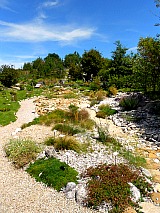
The Vegetation of River Beds
Next to this area is a section dedicated to river bed associations (see image above): in these habitats, diversification of the vegetation types depends on the morphology of the actual river beds, plus on other variable factors such as the nature of rock and the dynamic of water (how it flows, etc).
Differences in the size of the material brought by rivers is in strict relation to the proximity of the mountain slopes, the steepness of the location and again the speed of water, which can drag big boulders down to the valley floors or lead to deposits of silt and clay in areas where the water flow is slower.
This is how different conditions of humidity and availability of nutrients can affect the formation of diverse habitats.
Close to the water, on sands that are periodically flooded, one can encounter plants such as Calamagrostis pseudophragmites and Melilotus alba; on the contrary, wherever natural terraces (‘terrazzamenti’) have formed – which are skirted by water only in the event of exceptional floods – one can see thickets of willow with Salix eleagnos and S. purpurea, interspersed occasionally with Sea Buckthorn, Hippophae rhamnoides. Lastly, if the process of soil development allows it, the succession is completed by riverine thickets of White alder (Alnus incana).
In the group of Col Nudo-Monte Cavallo (maximum altitude 2,472 m), the vegetation of river beds presents subtle differences depending on the aspect of the slopes, while in the Alpago basin – where the rock layers were not significantly tilted by geological processes, if not at the summit – the river beds are overlaid with more recent rocks, mainly constituted of marl and softer sandstone.
As the upper limit of this lithologic type (1,000 – 1,200 m) coincides with the altitude of the main source of most of the calcareous material that forms the Alpine river beds, the latter are rich in silt and clay, which are preferred by those plants that are more exigent in terms of humidity and nutrients – such as Polygonum lapathifolium, Wild Rocket (Diplotaxis tenuifolia) and Bidens tripartita.
On the Friuli side, the rock layers of Cansiglio are interrupted by a steep rock wall that precipitates on the Vajont and Cellina valleys, offloading there a massive quantity of detritus which, when set in motion by abundant precipitations (yearly rainfall averages here 2,500 mm), eventually reaches the valley floors.
The calcareous and permeable component of the river beds – to which new rock material is frequently added – allows the settling of plant species that particularly favour gravelly locations (‘glareicole’ in Italian), which are in fact more typical of higher altitudes – such as the Dock Rumex scutatus and Arabis alpina.
On the more consolidated natural terraces (terrazzamenti) one can admire Berini’s Dandelion, (Leontodon berinii; see picture below); Chondrilla chondrilloides and Dodonaeus’ Pink (Epilobium dodonaei).
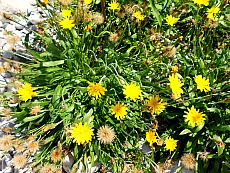
This section is completed by an area dedicated to the formations of the ‘magredi’: this is how the typically dry, wide river beds of the northwestern plains of Friuli are called.
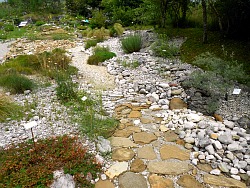
The ‘magredi’ Formations
The ‘magredi’ are formed by the peculiar alluvial nature of the soil, and in the garden it is particularly taken into account the Cellina river bed, which skirts Cansiglio to the east (above, an image of the area dedicated to the ‘magredi’ inside the Cansiglio Botanical Garden).
The ‘magredi’ are mainly constituted by gravel and pebbles that typically confer to the soil a high permeability. On the more recent terraces (alluvial plains) – known in Italian as ‘grave’ – finds its home a pioneer vegetation which is mainly composed of warmth-loving species (‘termofile’ in Italian), such as Fumana procumbens and Scorzonera austriaca.
To these, one must add a high contingent of montane and Sub-alpine species typical of more elevated areas – such as Mountain Avens (Dryas octopetala; pictured further up the page), Sesleria varia and Helianthemum oleandicum subsp. alpestre.
This vegetation evolves by successive stages towards more compact and homogeneous formations – that is, the ‘magredi’ proper – whilst the landscape retains the original character of a steppic land.
The dry and desolate nature of these gravelly fields allowed them not to be used extensively – if nor for grazing; in turn, this has kept these environments relatively intact, and quite unmodified by man (something which did not happen to the surrounding habitats instead).
This particular association contains species of very high naturalistic value, such as Yellow Cornflower (Centaurea dichroantha), Carnia Stock (Matthiola vallesiaca), Friuli Cabbage (Brassica glabrescens) and Tatarian Kale (Crambe tatarica).
As a note of curiousity, this latter plant (pictured in blossom below) comes from Central Asia – very likely an edible crop in its place of origin – and it probably arrived here with the Huns invasion in the 5th century AD.
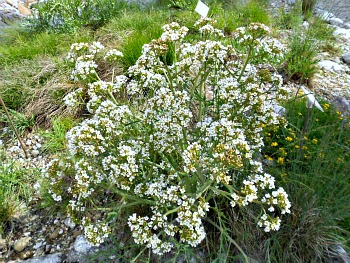
The Vegetation of Dry Lands
This area is dedicated to the dry meadows – those herbaceous formations of either hills or low mountains that populate sunny and arid slopes.
Aridity, here, depends mainly on the nature of the soil (“edaphic aridity”) rather than on the quantity of precipitation (in fact, as stated already, rainfall is quite abundant in the Cansiglio), as the calcareous soil – quite primitive and incoherent – allows for a rapid outflow of rainfall water.
In the meager overall balance of local water reserves, wind plays a vital role too: the circulation of hot and dry air contributes to further desiccate the microhabitats in the more exposed locations, such as slopes and ridges.
From time to time, natural fires – generated by the abundance of dry grasses, as well as by the activities of man – also contribute to the maintenance of these particular conditions.
In the Alps, dry fields and meadows often represent the last outpost for eastern species that have their origins in the steppes of Central Asia.
These include, for instance, grasses belonging to the genera Bromus, Festuca and Stipa (this latter name being in itself a reminder of the place of origin of these plants – the steppe).
Bromus – whose name is used to define the associations of dry fields in general, in their humid (“meso-brometalia”) and arid (“xero-brometalia”) variants – is a genus present in almost all dry fields habitats.
To the former (“meso-brometalia”) belong of course the leading species, Bromus erectus, plus other plants such as Filipendula vulgaris, Galium verum and Potentilla alba.
Here the soil is more developed, not only for the more favourable environmental conditions, but also because of human use, which – mainly through hay-making – has ameliorated the general quality of the topsoil and prevented the invasion of alien species (both in terms of trees and shrubs).
Here it is also where certain plants that are typical of the dry lands of the high plains of Friuli – the area between Vittorio Veneto and Maniago – can be admired.
This band of foothills is where the typical xerophylous (i.e. adapeted to aridity) vegetation of the Pre-alps is accompanied by species of more Mediterranean and Eastern provenance – such as Bromus condensatus and Convolvolus cantabrica; scented plants like Satureja montana and Inula ensifolia are also present in this context.
The section of the garden that leads towards the panoramic point allows to acknowledge oneself with the typical vegetation of the meadows of Cansiglio.
The first section crosses a population of Deschampia caespitosa – an invasive grass that is disdained even by grazing animals for its coarse and cutting leaves, and which for that reason is spreading more and more, as it is very competitive. Its tendency is to colonize not just abandoned or under-used fields, but also wood clearings and more open woodland in general.
Past this area, one encounters a small sink-hole (‘doline’), where the “scaglia grigia” (Grey Scale) – the predominant rock type in the Cansiglio area, especially in its western section – comes to the surface.
This is a calcareous rock, which is different from the cliff limestone – more compact and rich in fossils – that can be encountered by the karstic cavity called “Bus del Giaz” (the ice hole), always inside the garden. This latter lithologic type is more rich in clay and easily subdivided into many thin layers, thus presenting a more elevated tendency to break up.
From the panoramic point, one can enjoy a sweeping view over the whole of the Col Nudo-Monte Cavallo massif (maximum altitude 2,472 m), from Monte Dolada (1,938 m) to the west through to Col Mat (1,981 m) and Monte Cavallo itself (2,251 m) – to finish with the separate elevation of Monte Pizzoc (1,565 m) – to the east (below, see an image from the panoramic point).
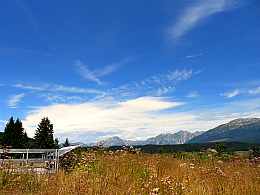
The last section of field to be crossed is an example of the meadows and pastures typical of the Cansiglio plateau and Valmenera; they belong to the association of the so-called “fat meadows” – with Festuca nigrescens and Cynosurus cristatus – in their various expressions.
The typical plant formation known as Festucetum-cinosuretum is settled on more favourable habitats, with different depths of soil; here, on the contrary, the morphology of the terrain and the aspect favour species of drier habitats such as Bromus erectus and Galium verum – especially on dry slopes where the bedrock is coming more to the surface.
If the soil is richer in clay and more acidic, one finds acid-loving species instead – such as Potentilla erecta, Hieracium pilosella and Bothrichium lunaria. Mixed in there also certain plants that the animals have learned to avoid, as they are poisonous – such as the dark-flowered Black False Helleborine (Veratrum nigrum; pictured below).
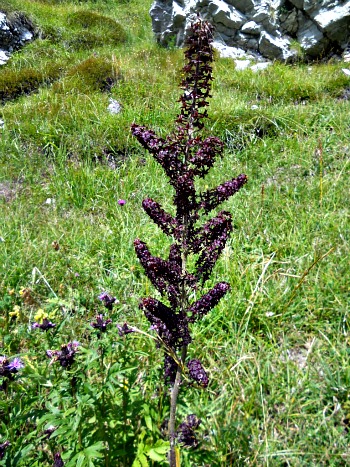
At the end of the panoramic trail, a group of beds hosts the more significant species of the montane association known as Nardetum: this important kenosis takes its name from the leading species, Nard (Nardus stricta) – a grass which typically colonizes acid soils, and with an inflorescence resembling a comb that makes it easily distinguishable from other grasses.
Initially, Mat-grass (or Nard) populates those stations in which snow lingers longer, or acid/acidified soils; it becomes predominant over other herbaceous species as it is not favoured by grazing animals, and quite resilient to being trampled upon too.
Excessive grazing can in fact favour the spreading of Nardus, although some species with beautiful blossoms can also find their home in this association; amongst these, Koch’s Gentian (Gentiana kochiana), Mountain Arnica (Arnica montana) and Antennaria dioica.
Descending back towards the main entrance now, one encounters formations dominated by Norway spruce, which is present here with some notable specimens.
In the more elevated altimetric band, where thermal inversion phenomena are stronger (as it is in fact on the all of the Cansiglio plateau) and climatic conditions do not allow the presence of beech, Norway spruce becomes the dominant species, giving rise to extensive formations which have also been replenished, over time, by artificial plantations.
In the past, this species was widely planted for its capacity to give good quality working timber, and for its high adaptability to the most adverse climatic conditions; for this reason, in the past, there have been massive plantations of Norway spruce for timber production in Cansiglio, but these artificial woods have often resulted in quite fragile and unstable environments, as witnessed by the attacks of a parasite that in the 1980s has killed more than 150 hectares of pure spruce woodland.
The very trees that can be seen in the garden are in fact the remains of artificial plantations mostly dating back to the 1920s. These woods, in general, are characterized by a particularly poor under-storey vegetation.
Nonetheless, in some sections of Cansiglio – and in particular in the karstic depressions – Norway spruce is accompanied by some species characteristic of the Sub-alpine conifer formations; first and foremost Blueberries (Vaccinium myrtillus and V. vitis-ideaea), but then also other species – such as Moneses uniflora, Orthilia secunda and Pyrola minor – can be found.
In one single location within the Cansiglio forest, the Orchid Listera cordata can be spotted: this is a species that is particularly difficult to observe not only for its rarity but also for its small size; its presence is a reminder of the natural origin of these woodlands, prior to Norway spruce plantations.
It is interesting to note, however, that from recent studies on pollens – which were carried out in the peat bog at Palughetto – Norway spruce seems to have been present in the Cansiglio already 12,000 years ago – and perhaps even as far back as 34,000 years ago in the Pian Cavallo area (Val Caltea).
This seems to suggest that this area was an important centre for the diffusion of this species already in the post-glacial era.
Officinal Plants
What we intend by officinal plants is a collection of plants that are traditionally used either in popular medicine or cooking.
In some cases, these species were already used in ancient times, while in other cases they have been present since relatively little time in pharmacy, phytotherapy or homeopathy.
Some species derive in fact their names from the ancient use of the plant – the so-called “science of signatures”, very popular in the Middle Ages, and usually related to the shape of a part of the plant resembling a corresponding part in the human body (that the plant was thought – sometimes rightly so – to cure).
This is the case, for instance, of Lungwort (Pulmonaria officinalis) or of Liverwort (Hepatica nobilis), related respectively to lung and liver. Notice that the English common names – still in use today – make a reference precisely to this use of the plant.
Currently, officinal plants are either used directly as home-remedies in decoctions, herb teas and tinctures, or the active principles are being extracted from various parts (flowers, leaves, roots) with more laboriuos processes; in either case, they are at the basis of numerous pharmaceutical products, some of which are quite well-known and still widely used.
This is the case, for instance, of Valerian (Valeriana officinalis) – a famous plant which contains a phyto-complex that is useful for curing disturbances of sleep – or of Mountain Arnica, a poisonous plant that is traditionally used for producing creams or spirits to be applied externally on parts of the body affected by rheumatic pains or contusions.
Plants in this section are grouped in rows, forming two beds and ordered by the type of soil they prefer; a third row is dedicated to the cultivation of species that, although not autochthonous, could adapt well to the rigid climate of Cansiglio – such as Echinacea (E. purpurea, E. angustifolia; first picture below), of North American origin, or the giant Yellow Gentian, native to the Alps but usually found at higher altitudes (Gentiana symphandra; second picture below).
This is a very useful part of the garden, as it has at least two purposes: on the one hand it has an educational goal, as it can help reconnect the visitor to the traditional uses of plants, all too often forgotten; on the other hand, the trial of introducing new species to Cansiglio could have interesting implications with a view of promoting the cultivation of officinal plants on the plateau both as an economic entreprise and as an activity connecting tourism with sustainable development.
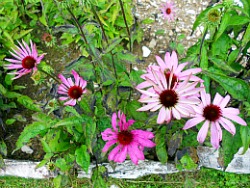
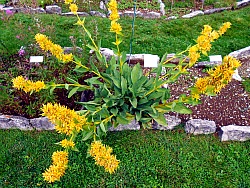
The ‘Arrhenatheretum’ Association
The Arrhenatheretum (Italian name ‘Arrenatereto’) – taking its name from the leading species Arrhenatherum elatius – refers to the typical plant association of hay meadows, which are subject to the abundant dispersal of manure that has supported grazing for centuries. These habitats are historically connected with the most important agricultural activity in this area: livestock farming (mainly of cattle).
In general, these are quite humid environments rich in nutrients, scythed regularly and moderately grazed. The Arrhenatheretum can be encountered from Sub-alpine slopes up to medium mountain habitats, where it tends to evolve into more developed plant associations.
Once these meadows were covered by a mixed woodland composed mainly of oak, hornbeam and beech, but with selective cuts, woodland clearing and the continuous dispersal of manure they have gradually evolved into the most characteristic habitat in the landscape of several mountain regions, including nearby Alpago.
This plant association derives its name from a grass, Arrhenatherum elatius – also known as ‘tall oats’, as it is a species that can reach a height of 1,5 metres. It is a vigorous fodder plant that is normally being cut for haymaking two or three times a year and sometimes – where climatic conditions allow it – even four.
The Arrhenatheretum has a generally elevated floristic composition, which can contain up to 60-70 species for every 100 square metres of surface. The peculiarity of this association is that every single cut differentiates it from the next by the species' composition.
In the first cut – normally carried out at the end of May – grasses from the Graminaceae family dominate, such as the leading species Arrenatherum elatius, Anthoxanthum odoratum and Poa pratensis, with other plants from the daisy family (Compositae), such as Taraxacum officinalis, Leucanthemum vulgare, Achillea roseo-alba, and various representatives of the pea family (Leguiminosae) – like Lotus corniculatus and Trifolium pratense – also present.
The second cut – normally taking place at the beginning of August – favours other members of the Leguiminosae and the Umbelliferae family, such as Pimpinella major and Wild Carrot, Daucus carota.
In the third – and usually last – cut (or the fourth where conditions allow it), which is carried out towards the end of September, there is a noticeable reduction in the number of species, and plants such as Dactylis glomerata and Black Cornflower (Centaurea nigrescens) take over.
The typical composition of the Arrhenatheretum – if the right conditions allow it – remains relatively constant, and does not change a lot with other factors related to morphology or orography of the terrain.
Unfortunately, changes in the agricultural practices – that have taken place at all levels of the productive cycle – have led to prefer the shedding of slurry instead of proper, ripe manure on the fields, with a consequent impoverishment in the number of species present, and the taking over of nitrophilous plants.
These are species that prefer a soil rich in nitrogen, and many of them are quite well-known plants often wrongly mistreated as weeds – such as Nettle, Dock and members of the Chenopodiaceae family like Wild Spinach (Chenopodium bonus-henricus; aka Good King Henry), which grow abundantly around dairy pens and farms.
As these species are not favoured by grazing animals they tend to spread, but the use that could be made of them by humans is either underestimated or it has been all but forgotten, while often these are plants rich in nutrients and medicinal properties. Hopefully, their presence in the garden will lead to treat – and use – them again in the future with the respect they deserve.
The Doline at the Alpine Botanical Garden
The Alpine Botanical Garden in Pian Cansiglio is also a place where it is possible to deepen the knowledge on themes which are not exclusively botanic and linked to naturalistic aspects, but also other topics that characterise the area, such as geomorphology. The Cansiglio is a karstic plateau in constant, slow evolution: the presence of numerous dolines and sinkholes are clear signs of these transformations. Inside the Botanical Garden, it is possible to walk an itinerary dedicated to these themes, and visit the Bus del Giaz -- a 9-meter deep sinkhole -- and a short karstic trail, enriched with informative panels on geomorphology and karstic phenomena.
The phenomenon of karstic dissolution is based on chemical-physical transformation of carbonatic rocks into soluble calcium bi-carbonate, thanks to the work of water. This phenomenon is also responsible both for the formation of the hypogean (subterranean) karstic systems, several hundreds of km long, and even more than 1,000 m deep between the entry point and the explored bottom; and the surface (or superificial) karstic morphologies, with long and wide basins (known as polje, or uvala), which sometimes can also be several km long, as well as smaller corrosion pools (dolines).
Doline is a term of Slovene origin (from dol, valley), which indicates a small, superificial closed cavity, typical of the plateaus constituted of calcareous rocks, formed by the melting of calcium carbonate, of which they are formed. Generally speaking, they have a circular or oval shape; they can also have a variable dimension, both for width and depth, but these characteristics may change over time. A doline is formed by meteoric water, which is then filtered through fractures and subterranean passageways, but also by frequent collapses and adjustments, due to the disintegration of the rock masses, following the dissolution and the subterranean displacement or removal of lithic material, always due to the work of circulating water. If the bottom of the doline becomes impermeable because of clay deposits, the geomorphologic formation that derives is called a lama (pool).
Inside the doline, particular micro-habitats are created, characterised by low light levels, high humidity, and a marked thermal excursion (temperature variation), where animal and plant organisms live adapted to these conditions, in particular liverworts, mosses, lichens and ferns, sometimes rare (such as Cystopteris sudetica, recently reintroduced to the garden -- 2018). Inside these dolines, which are rather wide, can sometimes also grow trees, the most common of which is undoubtedly Normay Spruce (Picea abies), which gives rise to a specific forest formation precisely called Doline picetum, identified with the code 9410, Acidophilous montane and Alpine Picea forests (Vaccinio-picetea), within the Nature 2000 Network coding system. In this doline, is also evident the presence of grey scale (scaglia grigia), a typical rock formation in the Cansiglio, composed of limestone and marl, which surfaces in large areas of the plateau, breaking up in scales of various dimensions, following karstic dissolution phenomena.
The LIFE+ManFor Trail in Cansiglio
Even though it has no direct connection with the Botanical Garden, there is – in the Cansiglio – also an interesting trail dedicated to the forest habitats, and the way in which forests can assist in mitigating the effects of climate change. Albeit brief, and not so easy to find, this trail provides nevertheless an opportunity to learn more on a very important topic, and within an atmospheric woodland setting. More detailed information, together with a detailed description of the LIFE+ManFor trail, can be seen on a dedicated page, Cansiglio LIFE Project.
Return from Cansiglio Alpine Flora to Cansiglio
Return from Cansiglio Alpine Flora to Italy-Tours-in-Nature
Copyright © 2013 Italy-Tours-in-Nature

New! Comments
Have your say about what you just read! Leave me a comment in the box below.